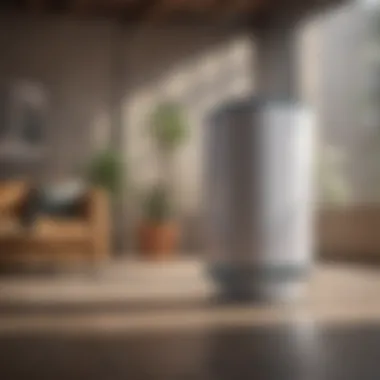Effective Strategies for Disinfecting Air in Your Home


Intro
In recent years, air quality has increasingly become a focal point in discussions related to health and well-being. Many people are now aware of the often-overlooked fact that indoor air can be more polluted than outdoor air. As individuals spend a significant part of their day indoors, understanding effective strategies to disinfect the air in homes becomes imperative. This article will delve into various techniques, both technological and natural, that can help in enhancing air quality. By examining the benefits and limitations of these methods, homeowners will be equipped with the knowledge to make informed decisions regarding their living environment.
Feature Spotlight
Technological Solutions
The advancement of technology has opened up numerous possibilities for improving indoor air quality. Among the most popular solutions are air purifiers. These devices use various filtration systems to remove particulate matter, allergens, and harmful toxins from the air.
Key types of air purifiers include:
- HEPA Air Purifiers: Known for their effectiveness in removing 99.97% of particles measuring 0.3 microns or larger, HEPA filters are ideal for capturing dust, pollen, and pet dander.
- Activated Carbon Filters: These filters specialize in absorbing odors and volatile organic compounds (VOCs). They work by trapping gases and chemicals in their porous structure.
- UV-C Light Air Purifiers: Utilizing ultraviolet light, these purifiers destroy pathogens such as bacteria and viruses that can compromise air quality.
When selecting an air purifier, homeowners should consider factors like room size, noise level, and filter replacement costs. Regular maintenance is also crucial to ensure the devices function effectively.
Plant-Based Solutions
Incorporating plants into your home can be another effective strategy for improving air quality. Certain plants are known for their ability to absorb toxins and increase oxygen levels. Popular examples include:
- Snake Plant: This hardy plant can thrive in a variety of conditions and is effective in removing formaldehyde and benzene.
- Spider Plant: Known for its air-purifying capabilities, it can eliminate pollutants such as carbon monoxide and xylene.
- Peace Lily: This plant not only improves air quality but also enhances a home’s aesthetic appeal.
It is important to note that while plants can aid in air purification, they should not be solely relied upon. Combining them with other methods can yield better results.
Synthesis of Strategies
Enhancing indoor air quality requires a multi-faceted approach. Finding the right balance between technology and nature can lead to significant improvements. Homeowners should evaluate their specific needs and conditions before implementing strategies.
For example, those in urban areas may consider investing in high-quality HEPA purifiers due to higher levels of particulates from external sources. Alternatively, individuals living in rural settings might benefit from incorporating more plants, as outside air may have fewer pollutants.
Establishing a cleaning routine that includes regular dusting, vacuuming, and proper ventilation can also significantly contribute to better air quality.
"Investing in the quality of air in your home is as crucial as maintaining the physical structure of your residence."
In summary, by understanding and applying a variety of methods for disinfecting air in the home, individuals can create healthier living environments. This not only enhances comfort but also plays a vital role in overall health.
Understanding Indoor Air Quality
Indoor air quality is a crucial aspect of maintaining a healthy living environment. In recent years, it has become increasingly evident how vital air quality is to our overall well-being. Poor air quality can lead to various health issues and discomfort. Understanding indoor air quality entails recognizing the factors that affect it and knowing the implications of neglecting these elements.
Definition of Indoor Air Quality
Indoor air quality refers to the condition of the air within a building, particularly as it relates to the health and comfort of its occupants. This includes the presence of pollutants, moisture levels, and ventilatory exchanges. Good indoor air quality means that the air is clean, free from contaminants, and conducive to health. In contrast, poor air quality can be a hidden danger that affects physical and psychological well-being.
Factors Affecting Indoor Air Quality
Several factors can significantly influence indoor air quality. Understanding these factors helps in implementing solutions to ensure a cleaner and healthier environment.
Pollutants
Pollutants are a primary concern for indoor air quality. They can originate from various sources, such as volatile organic compounds (VOCs), particulate matter, and biological contaminants like mold. These substances not only reduce air quality but can also pose various health risks. The distinctive characteristic of pollutants is their ability to accumulate in indoor environments, leading to prolonged exposure. Addressing these pollutants is essential for the strategies discussed later in this article, as they are a significant barrier to achieving clean air.


Humidity levels
Humidity levels play a vital role in determining indoor air quality. The balance of humidity in a home can affect comfort and health. High humidity can foster mold growth, while too little moisture can lead to dry skin and respiratory issues. Maintaining optimal humidity levels is a beneficial strategy for improving air quality and comfort. The unique feature of humidity management is that it is often overlooked, yet it is fundamental in guiding other air quality improvement strategies.
Ventilation
Ventilation is another critical factor affecting indoor air quality. Proper ventilation allows fresh air to circulate and helps dilute indoor pollutants. Good ventilation improves air exchange between the indoors and outdoors and can significantly enhance air quality. The key characteristic of effective ventilation is that it actively removes stale air and contaminants, replacing them with cleaner air from outside. Nevertheless, inadequate ventilation can lead to a buildup of pollutants, which can undermine efforts in air quality improvement.
Health Implications of Poor Air Quality
Poor indoor air quality can lead to various health issues, ranging from respiratory infections to long-term diseases. Common symptoms include eye, nose, and throat irritation, headaches, and fatigue. In extreme cases, chronic exposure to pollutants can contribute to severe conditions such as asthma and other respiratory diseases. It is essential to prioritize indoor air quality to ensure a healthier living space and improve the overall quality of life for all occupants.
Methods for Disinfecting Air
The methods we use to disinfect air in our homes are critical for maintaining a healthy living environment. As indoor air pollution continues to rise, it is vital to explore various strategies for effectively purifying the air. The utilization of various technologies and natural methods offers homeowners practical solutions. These methods help eliminate harmful pathogens, reduce allergens, and improve the overall air quality, contributing to better health. In this section, we delve into mechanical air purification, ultraviolet light technology, ionic air purifiers, and natural solutions, discussing their key characteristics and their roles in disinfecting indoor air.
Mechanical Air Purification
HEPA Filters
High Efficiency Particulate Air (HEPA) filters are a prominent choice in mechanical air purification. Their primary role is to trap airborne particles, including dust, pollen, and pet dander. A key characteristic of HEPA filters is their ability to capture at least 99.97% of particles as small as 0.3 microns. This feature makes them a beneficial option for improving indoor air quality. Using a HEPA filter significantly reduces the amount of pollutants in the air, enhancing health for inhabitants.
One unique advantage of HEPA filters is their passive nature. They do not release any byproducts back into the air. However, they require regular replacement to maintain efficiency. Moreover, these filters might restrict airflow, which can reduce the effectiveness of heating or air conditioning systems if not properly managed.
Activated Carbon Filters
Activated carbon filters also play an important role in air purification. They utilize a porous carbon material that adsorbs gases, odors, and volatile organic compounds (VOCs). This unique characteristic helps remove harmful substances from the air, making them a popular choice for homes. They are particularly effective at eliminating odors from cooking or pet waste, which contributes to a fresher indoor environment.
The main advantage of activated carbon filters is their ability to handle gaseous pollutants that HEPA filters cannot address. However, they do have limitations. Their effectiveness diminishes over time and requires regular maintenance or replacement. Additionally, they often work best in combination with HEPA filters for comprehensive air purification.
Ultraviolet Light Technology
Effectiveness Against Microorganisms
Ultraviolet (UV) light technology is gaining attention for its ability to disinfect air by targeting microorganisms. UV-C light effectively kills bacteria, viruses, and mold by damaging their DNA. This characteristic is why UV technology is a beneficial choice for improving indoor air quality. It is effective in settings like hospitals, but also increasingly used in homes.
The unique feature of UV light is its ability to disinfect without chemicals, making it an eco-friendly alternative. However, proper installation is crucial for maximum effectiveness, as the UV light must have adequate exposure to the air. Additionally, UV disinfection systems can be costly and require some maintenance to ensure they function properly.
Installation Considerations
When considering UV light systems, installation plays a vital role. These systems can be mounted within existing HVAC units, which enhances efficiency but requires professional expertise. A key characteristic is the need for precise positioning and orientation of the UV lamps.
Proper installation minimizes the potential for human exposure to ultraviolet rays, which is a concern. Furthermore, these systems need to be monitored for functionality to ensure they continue to disinfect air effectively over time. The initial cost and potential maintenance are factors to consider when implementing this technology in homes.
Ionic Air Purifiers
How They Function
Ionic air purifiers work by emitting negatively charged ions into the air. These ions attach to positively charged particles, causing them to clump together and fall to the ground or stick to surfaces. This operational mechanism is a unique characteristic of ionic purifiers, contributing to the overall goal of disinfecting indoor air.
One of the benefits of ionic air purifiers is their ability to reduce certain allergens and pollutants from the air. However, some models can generate ozone, which may be a concern for sensitive individuals. Therefore, it is essential to choose the right model and understand the implications of ozone generation.


Potential Concerns
While using ionic air purifiers has many advantages, there are potential concerns. One of them is related to indoor air ionization, which can lead to ozone production. Although ozone is beneficial in the upper atmosphere, at ground level, it can compromise air quality and health when inhaled.
Additionally, the particles collected by ionic purifiers may settle on surfaces, requiring regular cleaning. This can be an inconvenience for homeowners, as it contributes to maintenance efforts.
Natural Air Freshening Solutions
Houseplants
Houseplants are natural contributors to air purification, adding both aesthetics and health benefits to homes. They absorb carbon dioxide while releasing oxygen, enhancing overall air quality. A key characteristic of houseplants is their ability to filter out certain toxins, making them a beneficial choice for indoor settings.
The unique feature of houseplants is their multifunctionality. They not only improve air quality but also add beauty and can enhance moods. However, the effectiveness of plants varies widely, and having a diverse range can yield better results. Additionally, care routines can be another concern, as some people may struggle to provide consistent care for plants.
Essential Oils
Using essential oils is another effective way to freshen indoor air naturally. These oils can be diffused to emit pleasant aromas and can have antibacterial properties. A key characteristic of essential oils is their ability to mask unpleasant odors while also providing therapeutic benefits, making them a popular choice among homeowners.
One unique aspect of essential oils is their variety; different oils serve different purposes, from relaxation to energizing effects. However, safety is a concern, especially for pets and individuals with sensitivities. It is crucial to research any oils used. In addition, care should be taken regarding dosage, as excessive use can lead to overwhelming scents that may be off-putting.
Routine Maintenance for Air Quality
Routine maintenance is a critical aspect of ensuring good indoor air quality. It involves the regular upkeep of air purification systems and other elements that affect the air we breathe. Neglecting this maintenance can lead to ineffective air disinfection, which compromises health and well-being. Consistent attention to a few key areas significantly enhances the overall quality of indoor air, making it safer and more pleasant.
Filter Replacement Guidelines
Filters are the heart of any air purification system. For optimal performance, filters must be changed according to their specifications. This usually means replacing HEPA filters every six to 12 months, depending on usage and environmental factors. Clogged or dirty filters not only reduce airflow but also diminish the effectiveness of capturing airborne particles. Monitoring filter status can prevent this issue.
Cleaning and Maintenance Recommendations
Regular cleaning of air purifiers and HVAC systems is vital. Dust and debris can accumulate, hindering efficiency. Wipe external surfaces with a damp cloth to remove buildup. For HVAC systems, ensuring that ducts are clean can greatly contribute to air quality. Schedule a professional cleaning every few years for thorough servicing.
Monitoring Indoor Air Quality
Monitoring indoor air quality is essential in maintaining a clean and healthy environment. Without data, it is challenging to know the effectiveness of purifying strategies.
Air Quality Monitors
Air quality monitors measure various pollutants in your home, providing real-time data about the environment. They often focus on particulate matter, volatile organic compounds, and humidity levels. The key characteristic of these devices is their ability to offer immediate feedback on air quality. This makes them a beneficial choice for homeowners. Many models also feature alert systems that notify users when pollution levels rise. However, it is essential to select one that fits specific needs, as options may vary in sensitivity and range.
Data Interpretation
Data interpretation involves analyzing the information provided by air quality monitors. Knowing how to read this data is crucial for taking informed action. This aspect is important as it allows homeowners to recognize patterns and triggers for poor air quality. A unique feature of robust monitoring systems is their ability to correlate data with external conditions, such as weather or activity levels. This provides a comprehensive view, helping users address sources of pollution effectively. However, correctly interpreting this data may require a bit of technical knowledge, making user-friendly designs highly desirable.
Emerging Technologies and Innovations
Emerging technologies play a pivotal role in the pursuit of cleaner, healthier air within our homes. As pollution levels rise indoors, these innovations provide alternative methods to maintain indoor air quality. There is a significant focus on integrating modern technology to create efficient and user-friendly air purification solutions. By exploring smart options, photocatalytic methods, and advancements in nanotechnology, homeowners can discover versatile strategies tailored to their air quality needs.
Smart Air Purifiers
Smart air purifiers represent an important shift in air quality management. They connect with home automation systems, offering seamless control over air purification processes.


Integration with Home Automation
The integration of smart air purifiers with home automation systems enhances convenience for users. This capability allows individuals to monitor air quality and control purification settings through their smartphones or voice-activated devices. A key characteristic of this integration is its ability to operate autonomously based on real-time air quality data. It is a beneficial choice since it simplifies air management without constant manual input. One unique feature is the capability of these purifiers to send alerts when filters need to be replaced or when air quality dips below optimal levels. While convenient, homeowners must consider the potential for reliability issues, particularly with devices that depend heavily on internet connectivity.
User-Friendly Features
User-friendly features in smart air purifiers contribute significantly to usability and overall effectiveness. These may include touch screens, intuitive interfaces, and easy navigation options. Such features make it accessible for all members of the household to utilize, regardless of technical skill, which is why it is popular among many families. A notable advantage is the access to detailed air quality reports and the ability to adjust settings easily. However, one disadvantage can be the initial complexity of setup, which some users may find overwhelming without proper guidance.
Photocatalytic Oxidation
Photocatalytic oxidation represents a modern option for purifying air. This technology uses light to activate a catalyst, typically titanium dioxide, which in turn breaks down air pollutants. Its effectiveness against viruses and bacteria makes it a highly valued choice for improving indoor air quality. This method also generates fewer harmful byproducts compared to traditional air cleaning techniques. However, the need for consistent light exposure can limit its placement and efficiency in some home environments.
Nanotechnology in Air Purification
Nanotechnology in air purification introduces innovative materials that enhance filtration efficiency. Nanofilters can capture smaller particles than standard filters, improving the air cleaning process. This technology often involves engineered materials that possess unique properties, like increased surface area and reactivity. One of the key advantages is its ability to target specific pollutants that standard technologies might overlook. Nevertheless, the long-term implications and costs associated with these advanced systems remain under discussion among experts.
Regulatory Guidelines and Standards
Understanding Regulatory Guidelines and Standards is essential for ensuring safe and effective indoor air quality. These regulations provide a framework that helps households comply with air quality benchmarks, minimizing health risks associated with indoor pollutants. They are developed based on extensive research on the effects of various airborne contaminants on human health. Adhering to these guidelines can also enhance the comfort and well-being of occupants, making it a priority for homeowners.
Indoor Air Quality Standards
Indoor Air Quality Standards set specific thresholds for pollutants, moisture levels, and ventilation rates. Organizations like the Environmental Protection Agency (EPA) create guidelines to regulate the acceptable levels of various indoor contaminants.
For example:
- Particulate Matter (PM2.5): Recommended levels should not exceed 12 micrograms per cubic meter.
- Carbon Dioxide (CO2): Concentrations above 1000 parts per million can indicate inadequate ventilation.
Maintaining these standards is crucial. It prevents the development of mold, the proliferation of dust mites, and other air quality issues. Homeowners should consider regular checks to ensure their indoor environment remains within these established limits.
Recommendations by Health Organizations
Recommendations by Health Organizations reinforce the scientific basis for clean air in residential settings. Institutions such as the World Health Organization (WHO) and the Centers for Disease Control and Prevention (CDC) outline best practices to improve air quality. Among their recommendations:
- Ventilation: Sufficient airflow should be maintained to dilute indoor air pollutants.
- Humidity Control: Ideal indoor humidity levels should range between 30% to 50% to discourage mold growth.
- Regular Cleaning: Frequent dusting and vacuuming can significantly reduce allergens and particulates.
"Improving indoor air quality requires a combination of good practices, including awareness of local regulations, proactive home maintenance, and community initiatives." This notion emphasizes the collective effort needed to make significant progress in air quality management.
These guidelines and recommendations serve not just to provide a baseline for safety but also to encourage proactive engagement in air quality improvement. For any homeowner, being aware of these regulations is a step toward a healthier living environment.
Closure and Future Perspectives
The necessity for effective air disinfection strategies is becoming increasingly apparent. In the wake of rising indoor pollution and its associated health risks, understanding how to properly manage and enhance indoor air quality is crucial. This article has detailed various methods for disinfecting air in the home, highlighting both technological solutions and natural alternatives. The insights presented are intended to empower homeowners to take control of their living environments.
By integrating products such as HEPA filters and ionic air purifiers, individuals can significantly reduce airborne pollutants. Additionally, the benefits of natural solutions like houseplants can’t be underestimated, as they offer an excellent dual function of beautifying spaces while improving air quality.
Summary of Key Points
- Importance of Indoor Air Quality: Maintaining clean air can prevent health issues ranging from allergies to more serious respiratory conditions.
- Variety of Methods: There are both mechanical and natural methods for disinfecting air, allowing for personal preference and individual needs.
- Routine Maintenance: Regularly changing filters and monitoring air quality ensures that chosen solutions function effectively.
- Emerging Technologies: Advancements in air purification technologies are continuously improving effectiveness, making it essential to stay informed.
The Future of Indoor Air Disinfection
Looking forward, the future of indoor air disinfection appears promising. With ongoing research and development in air purification technologies, effective solutions will become even more efficient and accessible. Smart home integration, for example, allows consumers to monitor and manage air quality with ease.
The application of nanotechnology and photocatalytic oxidation presents exciting innovations that could redefine air purification. These methods promise greater efficiency in capturing and neutralizing pollutants. Moreover, as society becomes more aware of health implications tied to air quality, regulatory standards are likely to evolve, setting a higher bar for air quality in homes.
“Investing in a clean environment transcends health— it enhances quality of life and well-being.”







